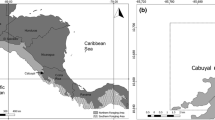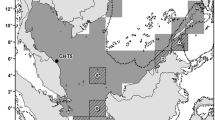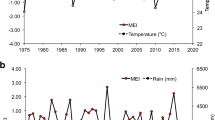Abstract
In species presenting long intervals between reproductive seasons, atmospheric-oceanic phenomena can affect the yearly number of individuals that become reproductively active. Sea turtles take multiyear intervals between reproductive seasons, which are influenced by environmental processes affecting their nutrition. Atmospheric-oceanic phenomena affect the reproductive output of different sea turtle species and populations. The population of green turtles (Chelonia mydas) nesting at Tortuguero-10.4489° N, 83.5069° W-, Costa Rica, is the largest in the Atlantic Basin and one of the most comprehensively studied. Nevertheless, only one study analyzed the effects of sea surface temperature on the reproductive output of Tortuguero green turtles. We analyzed three decades of data that revealed two likely scenarios: (1) more green turtle clutches were laid at Tortuguero after warm sea surface temperature anomalies during boreal winters and (2) fewer green turtle clutches were laid at Tortuguero 2 years after El Niño and more green turtle clutches were laid 2 years after La Niña events. Atmospheric-oceanic phenomena affect green turtle reproductive output likely through disrupting nutritional pathways, which alters the number of female green turtles that become reproductively active each year. Tortuguero green turtles are herbivorous feeding mostly on seagrass meadows off Nicaragua. As primary consumers, green turtles are tightly constrained by environmental conditions, and if the productivity of seagrass meadows decreased due to elevated sea surface temperature in the Caribbean basin or the altered hydric regime following El Niño events, fewer females would be able to accrue energy for reproduction.











Similar content being viewed by others
Data availability
The data that support the findings of this study are available from the Sea Turtle Conservancy but restrictions apply to the availability of these data, which were used under the authorization for the current study, and so are not publicly available. Data are, however, available from the authors upon reasonable request and with permission of the Sea Turtle Conservancy.
References
Ahmad-Kamil EI, Ramli R, Jaaman SA, Bali J, Al-Obaidi JR (2013) The effects of water parameters on monthly seagrass percentage cover in Lawas, east Malaysia. Sci World J. https://doi.org/10.1155/2013/892746
Alvarado-Diaz J, Arias-Coyotl E, Delgado-Trejo C (2003) Clutch frequency of Michoacan green sea turtle. J Herpetol 37(1):183–185
Ashok K, Behera SK, Rao SA, Weng H, Yamagata T (2007) El Niño Modoki and its possible teleconnection. J Geophys Res. https://doi.org/10.1029/2006JC003798
Balaz GH, Chaloupka M (2004) Thirty-year recovery trend in the once depleted hawaiian sea turtle stock. Biol Conserv 117(5):491–498. https://doi.org/10.1016/j.biocon.2003.08.008
Bellini C, Santos AJ, Grossman A, Marcovaldi MA, Barata PC (2012) Green turtle (Chelonia mydas) nesting on Atol das Rocas, north-eastern Brazil, 1990–2008 Marine Biological Association of the United Kingdom. J Mar Biol Assoc UK 93(4):1117
Bjorndal KA (1985) Nutritional ecology of sea turtles. Copeia 3(3):736–751. https://doi.org/10.2307/1444767
Bjorndal KA, Carr A (1989) Variation in clutch size and eggs size in the green turtle nesting population at Tortuguero. Costa Rica Herpetol 45(2):181–189
Bjorndal KA, Jackson JBC (2003) Roles of sea turtles in marine ecosystems: reconstructing the past. In: Lutz PL, Musick JA, Wyneken J (eds) The biology of sea turtles. CRC Press, Boca Raton
Bjorndal KA, Carr A, Meylan AB, Mortimer JA (1985) Reproductive biology of hawksbill Eretmochelys imbricata at Tortuguero, Costa Rica, with notes on the ecology of the species in the Caribbean. Biol Conserv 34:353–368. https://doi.org/10.1016/0006-3207(85)90040-0
Bjorndal KA, Wetherall JA, Bolten AB, Mortimer JA (1999) Twenty-six years of green turtle nesting at Tortuguero, Costa Rica: an encouraging trend. Conserv Biol 13(1):126–134. https://doi.org/10.1046/j.1523-1739.1999.97329.x
Bonnet X, Bradshaw D, Shine R (1998) Capital versus income breeding: an ectothermic perspective. Oikos 83(2):333–342
Broderick AC, Godley BJ, Hays GC (2001) Trophic status drives interannual variability in nesting numbers of marine turtles. Proc R Soc 2001:1481–1487. https://doi.org/10.1098/rspb.2001.1695
Broderick AC, Glen F, Godley BJ, Hays GC (2003) Variation in reproductive output of marine turtles. J Exp Mar Biol Ecol. https://doi.org/10.1016/S0022-0981(03)00003-0288:95-109
Carr A, Carr MH (1972) Site-fixity in the Caribbean green turtle. Ecology 53:425–429. https://doi.org/10.2307/1934228
Ceriani SA, Casale P, Brost M, Leone EH, Witherington BE (2019) Conservation implications of sea tturtle nesting trends: elusive recovery of a globally important loggerhead population. Ecosphere 10(11):1–19. https://doi.org/10.1002/ecs2.2936/full
Chaloupka MY, Kamekazi N, Limpus CJ (2008) Is climate change affecting the population dynamic of the endangered Pacific loggerhead sea turtle? J Exp Mar Biol Ecol 356:136–143. https://doi.org/10.1016/j.jembe.2007.12.009
Chen AA, Taylor MA (2002) Investigating the link between early season Caribbean rainfall and the El Niño +1 year. Int J Climatol 22:87–106. https://doi.org/10.1002/joc.711
Collier CJ, Waycott M (2014) Temperature extremes reduce seagrass growth and induce mortality. Mar Pollut Bull 83:483–490. https://doi.org/10.1016/j.marpolbul.2014.03.050
Congdon JD (1989) Proximate and evolutionary constraints on energy relations of reptiles. Physiol Zool 62(2):356–373. https://doi.org/10.1086/physzool.62.2.30156175
Congdon JD, Gibbons JW (1987) Morphological constraint on egg size: a challenge to optimal egg size theory? Proc Natl Acad Sci 84:4145–4147. https://doi.org/10.1073/pnas.84.12.4145
Craine JM, Towne EG, Joern A, Hamilton RG (2009) Consequences of climate variability for the performance of bison in tallgrass prairie. Glob Chang Biol 15:772–779. https://doi.org/10.1111/j.1365-2486.2008.01769.x
Craine JM, Towne EG, Tolleson D, Nippert JB (2012) Precipitation timing and grazer performance in a tallgrass prairie. Oikos 000:1–8. https://doi.org/10.1111/j.1600-0706.2012.20400.x
Delgado O, Ruiz J, Perez M, Romero J, Ballesteros E (1999) Effects of fish farming on seagrass (Posidonia oceanica) in a Mediterranean bay: seagrass decline after organic loading cessation. Oceanol Acta 22(1):109–117. https://doi.org/10.1016/S0399-1784(99)80037-1
Enfield DB (1996) Relationships of inter-American rainfall to tropical Atlantic and Pacfic SST variability. Geophys Res Lett 23:3305–3308. https://doi.org/10.1029/96GL03231
Enfield DB, Alfaro EJ (1999) The dependence of Caribbean rainfall on the interaction of the tropical Atlantic and Pacific oceans. J Clim 12:2093–2103. https://doi.org/10.1175/1520-0442(1999)012<2093:TDOCRO>2.0.CO;2
Enfield DB, Mayer DA (1997) Tropical Atlantic sea surface temperature variability and its relation to El Niño-Southern Oscillation. J Geophys Res 102:929–945. https://doi.org/10.1029/96JC03296
Fahrmeir L, Lang S (2001) Bayesian inference for generalized additive mixed models on Markov random field priors. Appl Statist 50(2):201–220. https://doi.org/10.1111/1467-9876.00229
Frankovich TA, Fourqurean JW (1997) Seagrass epiphyte loads along a nutrient availability gradient, Florida Bay, USA. Mar Ecol Prog Ser 159:37–50. https://doi.org/10.3354/meps159037
Frazer NB, Richardson JI (1985) Annual variation in clutch size and frequency for loggerhead turtles, Caretta caretta, nesting at Little Cumberland Island, Georgia, USA. Herpetologica 41(3):246–251
Giannini A, Kushnir Y, Cane MA (2000a) Interannual variability of the caribbean rainfall, ENSO, and the Atlantic Ocean. J Clim 13:297–310. https://doi.org/10.1175/1520-0442(2000)013<0297:IVOCRE>2.0.CO;2
Giannini A, Kushnir Y, Cane MA (2000b) Seasonality in the impact of ENSO and the North Atlantic High on Caribbean rainfall. Phys Chem Earth (B) 26(2):143–147
Hamman M, Limpus CJ, Whittier JM (2002) Patterns of lipid storage in the female green sea turtle (Chelonia mydas). J Comp Physiol B 172:485–493. https://doi.org/10.1007/s00360-002-0271-2
Hatase H, Tsukamoto K (2008) Smaller longer, larger shorter: energy budget calculations explain intrapopulation variation in remigration intervals for loggerhead sea turtles (Caretta caretta). Can J Zool 86:595–600. https://doi.org/10.1139/Z08-035
Hays GC (2000) The implications of variable remigration intervals for the assessment of population size in marine turtles. J Theor Biol 206:221–227. https://doi.org/10.1006/jtbi.2000.2116
Huang B, Thorne PW, Banzon VF, Boyer T, Chepurin G, Wrimore JH, Menne MJ, Smith TM, Vose RS, Zhang H (2017) Extended reconstructed sea surface temperatures, Version 5 (ERSSTv5): upgrades, validations, and intercomparisons. J Clim 30:8179–8204. https://doi.org/10.1175/JCLI-D-16-0836.1
Johnson SA, Ehrhart LM (1996) Reproductive ecology of the Florida green turtle: clutch frequency. J Herpetol 30(3):407–410
Kendrick GA, Nowicki RJ, Olsen YS, Strydom S, Fraser MW, Sinclair EA, Statton J, Hovey RK, Thomson JA, Burkholder DA, McMahon KM, Kilminster K, Hetzel Y, Fourqurean JW, Heithaus MR, Orth RJ (2019) A systematic review of how multiple stressors from an extreme event drove ecosystem-wide loss of resilience in an iconic seagrass community. Front Mar Sci. https://doi.org/10.3389/fmars.2019.00455
Lagueux CJ (1998) Marine turtle fishery of Caribbean Nicaragua: Human use patterns and harvest trends. PhD Dissertation, University of Florida, FL.
Lefcheck JS, Wilcox DJ, Murphy RR, Marion SR, Orth RJ (2017) Multiple stressors threaten the imperiled coastal foundation species eelgrass (Zostera marina) in Chesapeake Bay, USA. Glob Chang Biol 23(9):3474–3483. https://doi.org/10.1111/gcb.13623
Limpus CJ, Nicholls N (1988) The Southern Oscillation regulates the annual numbers of green turtles (Chelonia mydas) breeding around northern Australia. Aust Wildl Res 15:157–161
Limpus CJ, Nicholls N (2000) ENSO regulation of Indo-Pacific green turtle populations. In: Hammer GL, Nicholls N, Mitchell C (eds) Applications of Seasonal Climate Forecasting in Agricultural and Natural Ecosystems. Springer, Netherlands, pp 399–408. https://doi.org/10.1007/978-94-015-9351-9_24
Limpus CJ, Miller JD, Parmenter CJ, Limpus DJ (2003) The green turtle, Clehonia mydas, population of Raine Island and the northern Great Barrier Reef: 1843–2001. Mem Qld Mus 49(1):349–440
Lin H, Lee C, Peng S, Hung M, Liu P, Mayfield AB (2018) The effects of El Niño-Southern Oscillation events on intertidal seagrass beds over a long-term timescale. Glob Chan Biol 24(10):4566–4580. https://doi.org/10.1111/gcb.14404
Lough JM (1994) Climate variation and El Niño Southern Oscillation events on the Great Barrier Reef: 1958–1987. Coral Reefs 13:181–195. https://doi.org/10.1007/BF00301197
Lough JM (2011) Great Barrier Reef coral luminescence reveals rainfall variability over northeastern Australia since the 17th century. Paleoceanography. https://doi.org/10.1029/2010PA002050
Lovern MB, Adams AL (2008) The effects of diet on plasma and yolk steroids in lizards (Anolis carolinensis). Integr Comp Biol 48(3):428–436. https://doi.org/10.1093/icb/icn058
Macey R, Oster G, Zahnley T (2000) Berkeley Madonna user’s guide. University of California, Berkeley
Mazzarella A, Giuliacci A, Scafetta N (2012) Quantifying the Multivariate ENSO Index (MEI) coupling to CO2 concentration and to the length of day variations. Theor Appl Climatol 111:601–607. https://doi.org/10.1007/s00704-012-0696-9
Miller JD (1997) Reproduction in sea turtles. In: Lutz PL, Musick JA (eds) The biology of sea turtles. CRC Press, Boca Raton, pp 199–222
Moreno J, Lobato E, Morales J, Merino S, La Puente M-D, Tomas G (2008) Pre-laying nutrition mediates maternal effects on offspring immune capacity and growth in the pied flycatcther. Oecologia 156(4):727–735. https://doi.org/10.1007/s00442-008-1029-7
Moss R, Watson A (1984) Maternal nutrition, egg quality and breeding success of the scottish ptarmigan Lagopus mutus. IBIS 126:212–220. https://doi.org/10.1111/j.1474-919X.1984.tb08000.x
Pachzelt A, Rammig A, Higghins S, Hickler T (2013) Coupling a physiological grazer populations model with a generalized model for vegetation dynamics. Ecol Model 263:92–102. https://doi.org/10.1016/j.ecolmodel.2013.04.025
Perrault JR, Wyneken J, Page-Karijan A, Merrill A, Miller D (2014) Seasonal trends in nesting leatherback turtle (Dermochelys coriacea) serum proteins further verify capital breeding hypothesis. Conserv Physiol 2:1–15. https://doi.org/10.1093/conphys/cou002
Polzonetti-Magni AM, Mosconi G, Soverchia L, Kikuyama S, Carnevali O (2004) Multihormonal control of vitellogenesis in lower vertebrates. Int Rev Cytol 239:1–46
Price ER, Wallace BP, Reina RD, Spotila JR, Paladino FV, Piedra R, Velez E (2004) Size, growth, and reproductive output of adult female leatherback turtles Dermochelys coriacea. Endanger Species Res 5:1–8. https://doi.org/10.3354/esr001041
Reina RD, Spotila JR, Paladino FV, Dunham AE (2009) Changed reproductive schedule of eastern Pacific leatherback turtles Dermochelys coriacea following the 1997–98 El Niño to La Niña transition. Endanger Species Res 7:155–161. https://doi.org/10.3354/esr00098
Restrepo JD, Zapata P, Diaz JM, Garzon-Ferreira J, Garcia CB (2006) Fluvial effluxes into the Caribbean Sea and their impact on coastal ecosystems: the Magdalen River, Colombia. Glob Planet Change 50:33–49. https://doi.org/10.1016/j.gloplacha.2005.09.002
Saba VS, Santidrián-Tomillo P, Reina RD, Spotila JR, Musick JA, Evans DA, Paladino FV (2007) The effect of the El Niño Southern Oscillation on the reproductive frequency of eastern Pacific leatherback turtles. J Appl Ecol 44:395–404. https://doi.org/10.1111/j.1365-2664.2007.01276.x
Santidrián Tomillo P, Fonseca LG, Ward M, Tankersley N, Robinson NJ, Orrego CM, Paladino FV, Saba VS (2020) The impacts of extreme El Niño events on sea turtle nesting populations. Clim Change. https://doi.org/10.1007/s10584-020-02658-w
Solow AR, Bjorndal KA, Bolten AB (2002) Annual variation in nesting numbers of marine turtles: the effect of sea surface temperature on re-migration intervals. Ecol Lett 5:742–746. https://doi.org/10.1046/j.1461-0248.2002.00374.x
Taylor MA, Enfield DB, Chen AA (2002) Influence of the tropical Atlantic versus the tropical Pacific on Caribbean rainfall. J Geophys Res 107:1–13. https://doi.org/10.1029/2001JC001097
Taylor MA, Stephenson TS, Owino A, Chen AA, Campbell JD (2011) Tropical gradients influences on Caribbean rainfall. J Geophys Res 116:1–14. https://doi.org/10.1029/2010JD015580
Trenberth KE (1997) The definition of El Niño. Br Am Meteorol Soc 78(12):2771–2777. https://doi.org/10.1175/1520-0477(1997)078<2771:TDOENO>2.0.CO;2
Troёng S, Chaloupka M (2007) Variation in adult annual survival probability and remigration intervals of sea turtles. Mar Biol 151:1721–1730. https://doi.org/10.1007/s00227-007-0611-6
Troёng S, Rankin E (2005) Long-term conservation efforts contribute to positive green turtle nesting trend at Tortuguero, Costa Rica. Biol Conserv 121:111–116. https://doi.org/10.1016/j.biocon.2004.04.014
Troёng S, Evans DR, Harrison E, Lagueux C (2005) Migration of green turtles Chelonia mydas from Tortuguero, Costa Rica. Mar Biol 148:435–447. https://doi.org/10.1007/s00227-005-0076-4
Warner DA, Lovern MB, Shine R (2007) Maternal nutrition affects reproductive output and sex allocation in a lizard with environmental sex determination. Proc R Soc B 274:883–890. https://doi.org/10.1098/rspb.2006.010
Waylen PR, Caviedes CN, Quesada ME (1996) Interannual variability of monthly precipitation in Costa Rica. J Clim 9:2606–2513. https://doi.org/10.1175/1520-0442(1996)009<2606:IVOMPI>2.0.CO;2
Wibbels T, Owens DW, Limpus CJ, Reed PC, Amoss MS (1990) Seasonal changes gonadal steroids associated with migration, mating, and nesting in the loggerhead sea turtle (Caretta caretta). Gen Comp Endocrinol 79:154–64
Wolter K, Timlin MS (2011) El Niño Southern Oscillation behaviour since 1871 as diagnosed in an extended multivariate ENSO index (MEI.ext). Int J Climatol 31:1074–1087. https://doi.org/10.1002/joc.2336
Acknowledgements
The authors thank the community and national park rangers of Tortuguero, Costa Rica, for their support. This project was funded by the Sea Turtle Conservancy, Southeastern Louisiana University, American Museum of Natural History, Sigma-Xi Society, Idea Wild, and National Geographic Society. Additionally, we thank Costa Rica Green Path and Varcli Piñares S.A. for the collaboration in our project. The author thanks all STC research assistants and staff and all the personnel from ASVO and ASOPROTOMA Tortuguero. Finally, the authors would like to thank Dr. Karen Bjorndal for the invaluable advice provided and revision of an earlier version of this manuscript.
Author information
Authors and Affiliations
Corresponding author
Ethics declarations
Conflict of interest
National research permits were obtained from the Costa Rican Ministry of Environment and renewed annually by the Sea Turtle Conservancy. The methodology described in this study did not include collecting data directly on animals. All procedures were carried out in situ and no samples had to be collected. This study was funded the Sea Turtle Conservancy, Southeastern Louisiana University, American Museum of Natural History, Sigma-Xi Society, Idea Wild, and National Geographic Society. The authors declare that they have no conflict of interest.
Additional information
Responsible Editor: P. Casale.
Publisher's Note
Springer Nature remains neutral with regard to jurisdictional claims in published maps and institutional affiliations.
Reviewed by V. S. Saba and B. Wallace.
Rights and permissions
About this article
Cite this article
Saragoça Bruno, R., Restrepo, J.A. & Valverde, R.A. Effects of El Niño Southern Oscillation and local ocean temperature on the reproductive output of green turtles (Chelonia mydas) nesting at Tortuguero, Costa Rica. Mar Biol 167, 128 (2020). https://doi.org/10.1007/s00227-020-03749-z
Received:
Accepted:
Published:
DOI: https://doi.org/10.1007/s00227-020-03749-z




